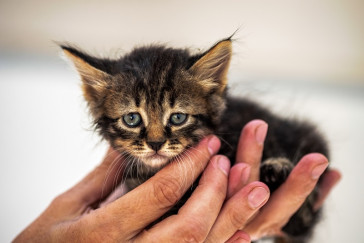Check Out The Top Warning Signs Your Cat Is Crying for Help

Cats are peculiar and complex animals. Their stealthy and silent nature can often give the impression that they are inherently independent in their endeavors and do not require the affection of humans. However, even the most placid and undemanding cat can cry for help without being obvious. Knowing your cat's warning signs for help can differentiate between intervention and consequence if their health suffers. Cats do not use words to describe how they feel, but they communicate through their behavior, posture, grooming, sleeping, and changes in daily routines.
1. Suddenly Hiding or Isolating
If your social cat suddenly hides in closets, under beds, or behind furniture for long periods, it can indicate a problem. Getting cozy and resting in an out-of-the-way place is normal, but something is wrong if your cat hides in isolation. One of the first signs that your cat cries for help is their reluctance to socialize and curtailing interactions with you or other pets. You might notice your cat does not greet you at the door when you come home, nor does it jump in your lap like it used to! Sometimes, we also need to remember that cats are hard-wired to mask or hide pain or illness, and will purposely try to isolate themselves when they can't mask being vulnerable or ill. Recognizing these behavioral changes is extremely important when recognizing signs that your cat cries for help.
Learn More: Check The Healthiest Dog Breeds Who Can Be Your Companions
2. Drastic Changes in Appetite or Thirst
Appetite changes excessive hunger or complete loss of interest in food-are some of the most common warning signs your cat cries for help. A cat that suddenly stops eating for more than 24 hours may be experiencing anything from dental pain to kidney disease. Likewise, a noticeable increase in water intake can be a sign of diabetes or hyperthyroidism. Both are serious conditions that require prompt veterinary attention. Don't brush off these changes as mere fussiness; they could be physical symptoms pointing to a larger health issue.
3. Unexplained Weight Loss or Gain
Cats changing weight isn't always just a cosmetic issue; it can signal much deeper issues. For instance, losing weight quickly may signal a metabolic issue, parasites, or gastrointestinal issues-physical signs that can escalate rapidly. Conversely, gaining weight suddenly (again, with lethargy) may indicate fluid retention due to heart disease or other irreversible chronic disease. This is one of the more subtle signs your cat is crying for help. Without weighing your cat regularly, this change can easily be missed. A simple body condition test at home and weight checks at your veterinarian can be a major stimulus to recognizing this health challenge.
4. Constant Vomiting or Diarrhea
Now, periodic vomiting may be a benign sign, particularly if it is rapid like a hairball. But if your cat is vomiting constantly (or chronic vomiting) and has diarrhea, this is not typical. Vomiting and diarrhea are physical signs in cats that their body is stressed. Underlying causes could be gastrointestinal upset, food allergies, other internal blockage, or even cancer. With these warning signs your cat is crying for help, this sign is particularly dangerous, as dehyrdration can develop rapidly with ongoing vomiting and diarrhea. Watch your litter box habits for frequency, patterns, and stool consistency, and report it to your veterinarian as early as possible.
5. Changes in Litter Box Habits
Is your cat missing the litter box, straining to urinate, or avoiding it altogether? These signs your cat is crying for help should never be ignored. Urinary tract infections (UTIs), bladder stones, and feline lower urinary tract disease (FLUTD) can cause painful elimination, prompting cats to associate the litter box with discomfort. Straining without producing urine is an emergency-particularly in male cats, where it may signal a life-threatening blockage. These are very clear physical symptoms that require immediate medical attention.

6. Excessive Vocalization
Has your typically quiet cat started meowing or yowling incessantly? Increased vocalizing, especially when accompanied by other behavioral shifts, can be one of the more apparent signs that something might be wrong with your cat. Cats may vocalize excessively, including pain, disorientation (commonly associated with aging in senior cats), or anxiety. If your cat is vocalizing for more time than usual, frequently at night or when you are not home, they could be making an emotional cry for help or have a more serious physical ailment.
Check This Out: Homemade Dog Food Supplement for Healthy, Happy Pets
7. Aggression or Uncharacteristic Behavior
A cat that has suddenly become aggressive biting, scratching, or hissing when you attempt to touch them, may be trying to tell you something is wrong. This change in temperament is one of the most alarming signs that your cat is crying for help. They may be experiencing painful physical symptoms, like arthritis, severe dental disease, or internal injury, that are unbearable to touch. Alternatively, they may be unusually affectionate, clingier, or seek more contact when usually they would favor staring at you from a distance and keeping soft at a 4-foot radius; this may indicate anxiety or confusion. Knowing that these mood swings may also be potential cries for help and require prompt and immediate care is crucial.
8. Poor Coat Condition or Overgrooming
Cats are fastidious groomers, so when their coat becomes greasy, matted, or unkempt, it often signals they're unwell. They may be in too much pain or discomfort to groom properly. This neglect of hygiene is one of the more visual signs that your cat is crying for help. Conversely, overgrooming especially in one spot may indicate allergies, anxiety, or skin infections. Both extremes are physical symptoms that shouldn't be ignored. A shiny, well-kept coat typically equals a healthy cat, so any significant deviation warrants attention.
9. Labored Breathing or Panting
Cats should never pant or breathe heavily under normal circumstances, unlike dogs. If you notice open-mouth breathing, rapid breathing, or visible effort in their breath, your cat must be seen by veterinary staff immediately. These are severe physical signs, one of the scariest warning signs a cat can display while crying for help. Respiratory distress could be caused by anything from heart disease to asthma, even fluid in the lungs. A cat having breathing issues may even try to hide, so being observant is essential.
10. Limping or Having Difficulty Jumping
Mobility issues are also clear signs that your cat is crying for help. Cats can hide arthritis or joint pain very well, but if your cat suddenly stops jumping onto its favorite perch or you see it limping, it probably hurts. Joint pain, injuries, or even neurological issues could cause these issues. These physical signs may not seem urgent when they happen, but if left untreated, they will greatly impact your cat's quality of life. Regular vet checkup appointments and basic mobility screenings can lead to successful early detection.
What to Do if You See Warning Signs
If you notice any of these signs your cat is crying for help, don't delay. Document the changes-when they started, how often they occur, and whether they get worse. Photos, videos, and notes can help your vet diagnose the problem more accurately. Some issues may require lab tests, X-rays, or even urgent interventions. The sooner you act, the better the outcome for your feline companion.
Keep in mind that many physical symptoms are interconnected. A cat vomiting may also refuse food, become lethargic, and hide-all signs that your cat cries for help. Viewing the bigger picture can help you understand the severity of the situation. When in doubt, always consult a professional. It's better to be overly cautious than to miss something serious.
Prevention and Proactive Care
In addition to assessing the warning signs that your cat is in distress, I would like to point out that it's important to be aware. Wellness checks, vaccinations, flea and parasite treatments, and nutrition will all enhance overall well-being. Adding plenty of mostly safe toys, perches, and hiding places to reduce anxiety-related symptoms, often mistaken for physical illness, will also provide prevention.
Be sure to regularly monitor your cat's weight, hydration, and litter box use. Using a pet health app or maintaining a journal can help you track this behaviour. Proactive care can lead to early identification of issues and prevent them altogether. By being aware and informed, your cat will have the best chance at a long, healthy, and happy life.
Also Read: Best Nutrition Guide for Pregnant Dogs - Healthy Pregnancy
Conclusion
Cats may be masters of disguise when dealing with pain and distress, but they give clues when something is wrong. Changes in grooming habits, increased vocalization, and unusual litter box behaviour are all signs that your cat is in distress and a call to action. Recognition and action on your cat's warning signs can be the difference between treatable and a crisis requiring medical intervention.
This content was created by AI





